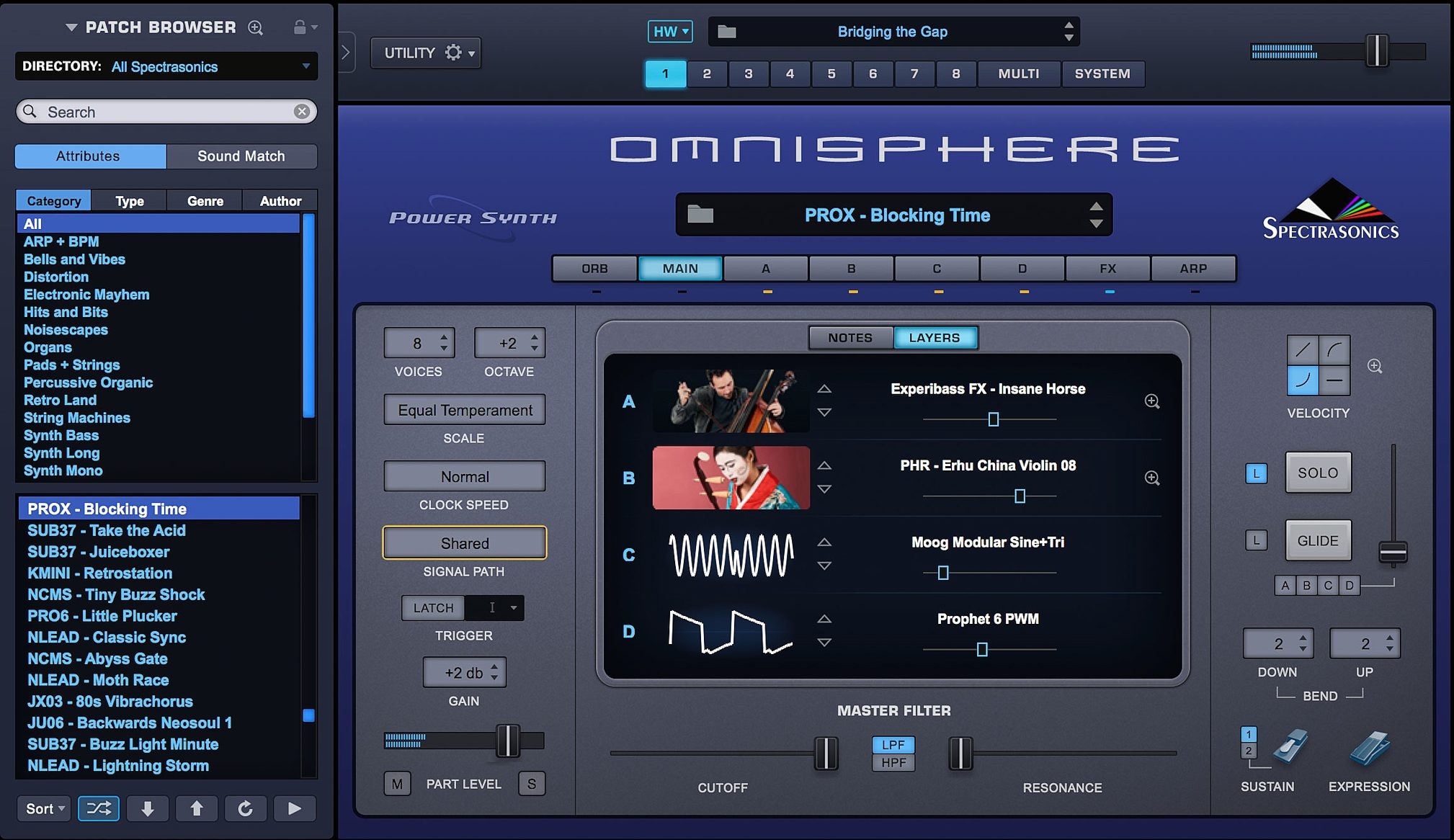Hardware Synth Integration
Sounds and all. Not a single missing sound and actually hearing the thing play. In FL Studio I changed the midi channel to 9 and nothing at all. FL Studio is reconizing the midi connection between omnisphere and the DAW itself. Just can't get a sound out of Omnisphere 2 in FL Studio, the volume meter won't even run.
Omnisphere is the only software synth in the world to offer a Hardware Synth Integration feature. This remarkable innovation transforms over 65 well-known hardware synthesizers into extensive hands-on controllers that unlock Omnisphere’s newly expanded synthesis capabilities. Simply put, this ground-breaking feature makes using Omnisphere feel just like using a hardware synth! By bridging the physical experience gap between software and hardware, users gain intuitive control of Omnisphere by using the familiar layout of their supported hardware synth. Virtual instrument users can now experience the joy of the hardware synth workflow and hardware synth users can fully expand their capabilities into the vast sonic world of Omnisphere!Roland JD-Xi
Roland JP-08
Roland JP-8000
Roland JU-06
Roland JUNO-106
Roland JX-03
Roland SE-02
Roland SH-01A
Roland SH-201
Roland D-50
Roland GAIA
Roland Super Jupiter
Roland System-1
Roland System-8
Roland VP-03
Korg microKorg
Korg Minilogue
Korg Minilogue XD
Korg Monologue
Korg MS-20ic
Korg MS-2000
Korg Prologue
Korg Radias
Moog Little Phatty
Moog Minitaur
Moog Sirin
Moog Slim Phatty
Moog Sub 37
Moog Subsequent 37
Moog Sub Phatty
Moog Voyager
Dave Smith Mopho
Dave Smith OB-6
Dave Smith Pro 2
Dave Smith Prophet 6
Dave Smith Prophet 8
Dave Smith Prophet 12
Dave Smith Prophet X
Dave Smith REV2
Nord Lead 1
Nord Lead 2
Nord Lead 3
Nord Lead 4
Nord Lead A1
Nord Stage 3
Nord Wave
Andromeda A6
Novation Bass Station II
Novation Circuit Mono Station
Novation MiniNova
Novation Peak
Virus A
Virus B
Virus C
Virus Indigo 1
Virus Indigo 2
Virus TI
Yamaha Reface CS
Studiologic Sledge
Deepmind
on Oct 23, 2015 in Synths & Sound Design 0 comments


Spectrasonics Omnisphere is known as one of the most powerful and best sounding software synthesizers on the market. It has just received another boost into the audio production stratosphere with its extensive 2.0 update, attracting new users and fans for its sound quality and design. It’s easy to get wrapped up in exploring and playing the thousands of patches available, especially the new additions. And without fault, there are so many usable sounds right of the box that can be used to enhance any production. Producers and composers alike should indulge!
That said, the purpose of this article is to explore the basics of custom synth patch creation using the powerful and easy to use interface in Omnisphere. Not only is the interface design intuitive, but also the complexity of what’s possible can keep the most seasoned music producers busy for months, if not years! If you do a search for custom Omnisphere patches, there are gurus out there selling their wares or offering free downloads of their creations. For those of you starting out with software synth programming, Omnisphere is a worthy investment and a good place to start.
In this article, I will give an overview of how to begin to program synth patches and very quickly find unique and inspiring sounds. I’ll go over types of waveforms, routing and using the modulation sections, where all the magic happens. Along the way, I’ll share some audio clips of my progress. By no means will I be able to cover everything is this short article, but I hope it inspires you to explore Omnisphere or another favorite software synth in your DAW. Come along for the ride as I lead you through my process.

In the Beginning: The Default Patch
When you load up Omnisphere into your DAW, the Default patch is loaded with a ‘SawSquare Fat’ waveform in the Synth window in the Oscillator section. This is the place where we can first select the basic waveform to build from or use a sample instead. For this article, we will be building from the synth generator. There are dozens of different waveforms to choose from including waveforms from Classic hardware synths, analog timbres and digital wavetables. I chose a classic Triangle wave from the top menu.
More Fun in the Oscillator Section
In the expanded oscillator section you have the option to add additional synthesis including FM (Frequency Modulation), Ring Modulation, Waveshaper and choose between Unison, Harmonia and Granular. They all change in the sound in different ways depending on your starting waveform so I would suggest staying in this area for quite a while and explore the options within each section. For my simple triangle wave, I chose to use the Unison section to fatten up the sound a bit. The Unison function makes slightly detuned copies of the original waveform and layers them to create the bigger sound. The spread slider widens the stereo field beautifully. Harmonia is great for creating chords by just pressing one note and Granular, a new synthesis feature in Version 2, is another specialized, but beautiful sound design option.
Synth Design Example 1—‘SawSquare Fat’, ‘Triangle’ and ‘Triangle with Unison’:
Playing with Modulation
Figure 4 – Quickly access Modulation drop down menu by right clicking on any parameter.
Back in the A section overview, I decided to play around with The Shape, Symmetry and Hard Sync sliders in the Oscillator section to bring more character to the sound. I also experimented with modulating each of these parameters through different LFOs operating at slightly different, slow rates. I quickly discovered that I was starting to create an interested Pad sound with evolving character. At this point I also went to my Amp Envelope section and adjusted the attack and release so that it was smooth on both ends when changing between chords. I also turned on the main Filter and modulated the Cutoff through LFO 4. I’ve included both samples with and without the Modulating filter cutoff so you can hear the difference. All these adjustments changed the sound dramatically from the previous ‘Unison’ example, as you’ll hear below.
Synth Design Example 2—Designing a Dynamic Pad Sound with Modulation routing, Filter and Amp Envelopes:
Figure 5 – Modulation Matrix Window in Omnisphere.
The Modulation section matrix window is a great place to try different sources and targets. Anything in the Oscillator section can be modulated with LFOs, envelopes and assigned to controllers like mod wheels. I felt more comfortable navigating this Mod section in particular compared to other software synths I’ve worked with.
Save and Tag your Custom Patch
One of most important steps in Synth patch creation is to save and tag your new sound so you do not loose all your hard work and time. You may find a few different variations of a patch during your synthesis process that warrant saving, naming and tagging for different musical purposes. The First step is to save your sound in the ‘User’ directory, make a Category for (in this case ‘Pad Sounds’) and then name your patch. In the ‘Edit Tags’ Screenshot below, I assigned some adjectives to the various attribute types available. I also added my name to the list as an author of that particular patch. It is important to be as detailed as possible so you can find the patch later when searching for similar sounds.
Figure 6 – Creating Tags for Custom Patches in Omnisphere.
Fun with Effects and Arpeggiation
Having completed one pad sound, I used it as a starting point to design another usable sound. I didn’t touch on the FX or Arpeggiator sections in the previous example, so I experimented with those to come up with another synth sound. I was interested in doing something more rhythmic and staccato. First, I made adjustments to my Amp envelope so I had a shorter Attack and Release. Then, I tried out some Arpeggiator presets, selected something close to what I was looking for, and then edited the timing and velocity. In the FX section, there are tons of directions to go with the sound. In this patch, I settled on using one of my favorite new FX in Omnisphere called Innerspace, an Envelope filter and Stereo Imager. My new result is featured below:
Synth Design Example 3—with Arpeggiation and FX:
Omnisphere No Sound Output
Figure 8 – FX Section Rack with Innerspace, Envelope Filter and Stereo Imager.
A World of Possibilities… Guided by You!
Omnisphere 2 No Sound Output 3
The world of synth programming is open to all producers and musicians regardless of experience. Software synths in particular are becoming so accessible that anyone can start to create unique sounds quickly. As I discovered on my journey, my custom patches started with a simple triangle wave and become so much more with just a few adjustments to various parameters. Whether you use Omnisphere or another synthesizer, I hope you feel encouraged to spend time exploring what’s possible.